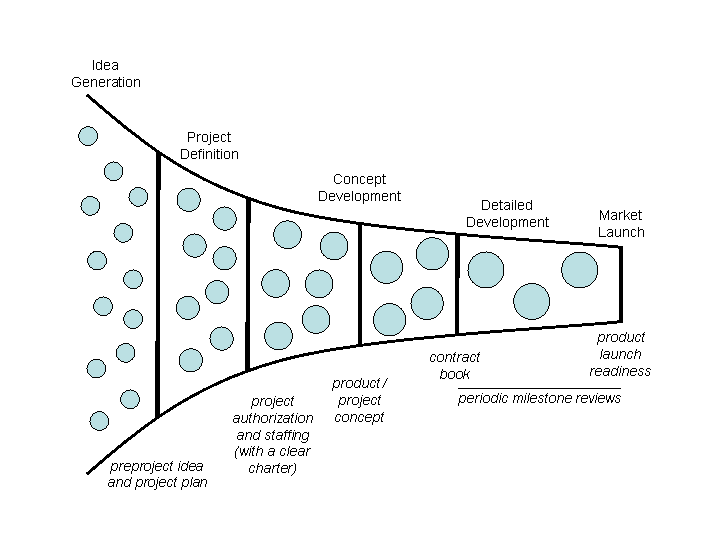Less is More
From Leading Product Development: The Senior Manager's Guide to Creating and Shaping the Enterprise, Steven Wheelwright and Kim Clark, The Free Press, New York, NY 1995
Four Roles for Senior Management
Direction Setter – Setting a direction for product development is more than laying out a business plan. Senior Management need to take steps to make the strategy specific and concrete in its implications for product development. They need to set goals for the firm’s development activities that will motivate action, guide decision making, and indicate what behaviors will be rewarded. They lay out a strategic direction and clarify where attention and resources must be applied; in this sense, Senior Management is building an agenda for action throughout the business. When such direction is linked to the selection of projects to be pursued and made a topic of discussions, review, and planning at executive staff meetings and in performance evaluations, such direction setting guides day-to-day action and creates a new reality.
This role is the vision / value setting role. The vision guides day-to-day action.
Product Line Architect – As in any journey, knowing the objective and having a clear direction is a useful starting point. But in product development, much more than direction is needed to establish strong connections between the business strategy and specific development projects. Essential to forging those links is action taken by Senior Management to define a framework for understanding the line of products the business offers today and plans to offer in the future. We call this framework the “product line architecture.” Because of the impact and importance of such architecture and the fact that it requires a broad, integrated perspective on customers, competitors, technology, and the firm’s capabilities and strategies, it is fundamentally a Senior Management role.
Product types:
Breakthrough - products that depart significantly and fundamentally from existing practive. They may introduce highly innovative product or process technology, open up a new market segment, or take the business into a totally new arena.
Platform - products that form the base of a family that can be leveraged over several years and across multiple market segments.
Derivative - products derived from (usually platform) products.
Support - products that entail only monor changes in technology, marketing, or processing to support the product line.
Architecting the product line: To create the architecture SM must project the business into the future, stop at the planning horizon and look back and ask, “What do we want the product line to look like, and how do we want it to evolve?”
An excellent tool for answering these questions is the product generation map. Four issues must be addressed to project the map into the future: Position, Type, Timing, Relationships.
Portfolio Manager – A product line architecture encourages Senior Management to think in terms of a portfolio of projects, in which individual projects represent deliberate efforts based on an assessment of what the organization (and its customers) wants the product line to look like in the future and what portfolio of development capabilities the business has to execute projects. As the portfolio manager, Senior Management needs to match up product line goals with new ideas, fold these ideas into specific projects, and match projects with development capability.
The Aggregate Project Plan (APP) is a powerful mechanism for managing the project portfolio and matching it with the capability portfolio. Two tasks are involved in making the APP: defining the project set and matching projects to capability and capacity.
Process Creator - Moving ideas to products through the development funnel – What Senior Management needs, in effect, is a process for applying the architecture and managing the project portfolio – a process Senior Management needs to create. The development funnel depicts a process in which the organization, led by Senior Management, generates a large number of ideas, screens them to find those with merit, organizes good ideas into potential projects, takes the best of the projects to build the APP, launches them when their time comes, and reviews their progress toward market introduction.
Four process imperatives:
- Creative ideas need to be encouraged and nurtured.
- Creative ideas need to be tested and evaluated.
- Creative ideas need to be combined with other creative ideas to define effective projects.
- Creative ideas need focused resources and staged commitments.
The Development Funnel: Project Screens and Milestones
- Idea Generation – Preproject idea and project plan
- Project Definition – Project authorization and staffing (with a clear charter)
- Concept Development – Product / project concept, contract book
- Detailed Development – Product launch readiness
- Market Launch
Putting it all together - The architecture, the Aggregate Project Plan, and the funnel must be coherent in content and timing. Two broad ways to pursue this integration: 1) Architecture driven - the product line architecture determines the timing and rhythm of screening decisions. Senior management uses the architecture to screen ideas and projects. 2) Idea driven approach - no specific market window that determines when projects get created or whether a project is approved. There is a broadly defined architecture for the product line, but the evolution of the ideas shapes the emerging architecture.
Most of the time, the two approaches need to be balanced.
